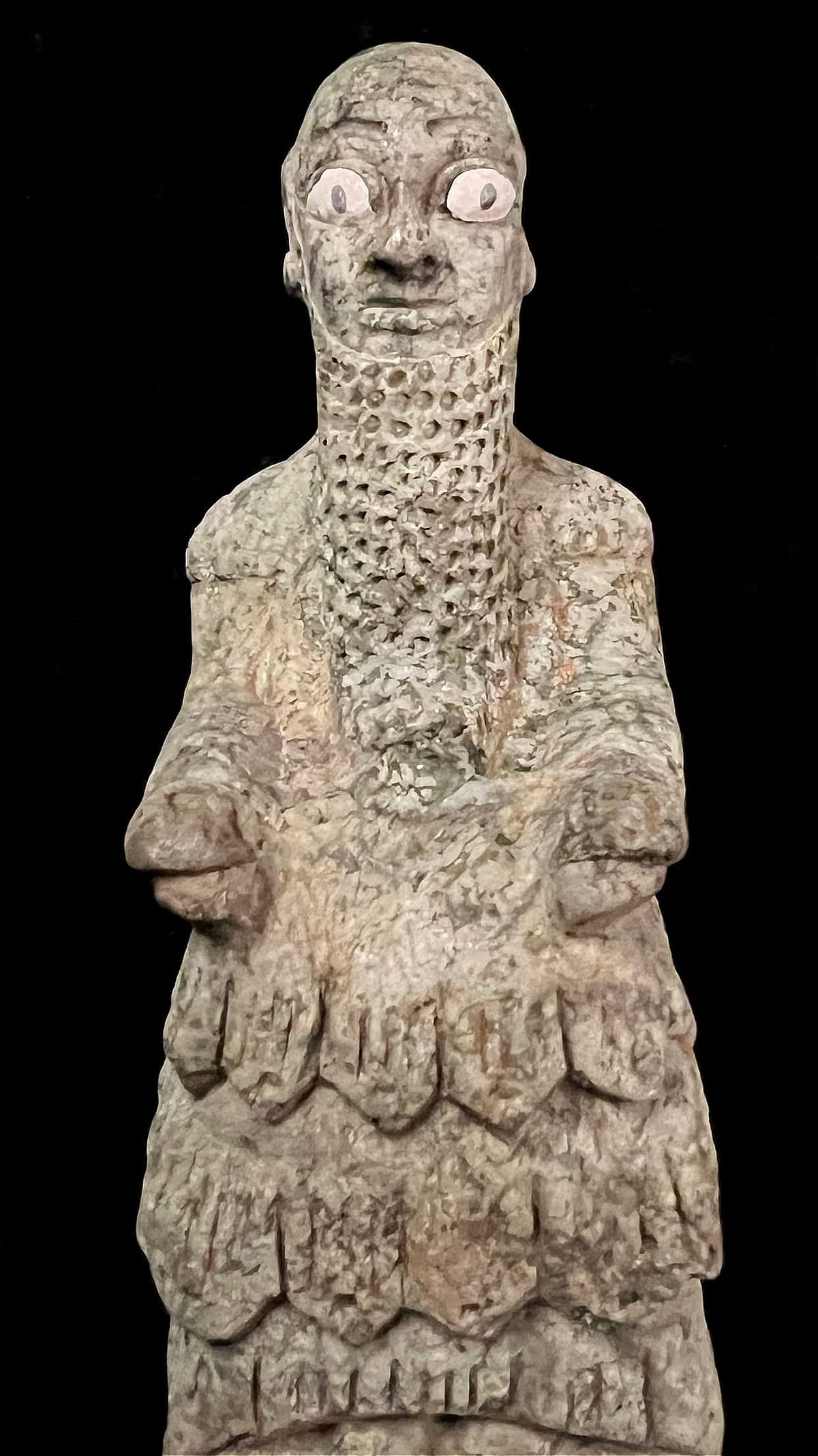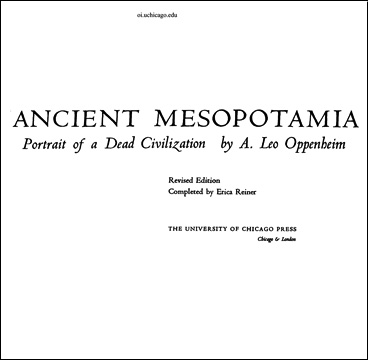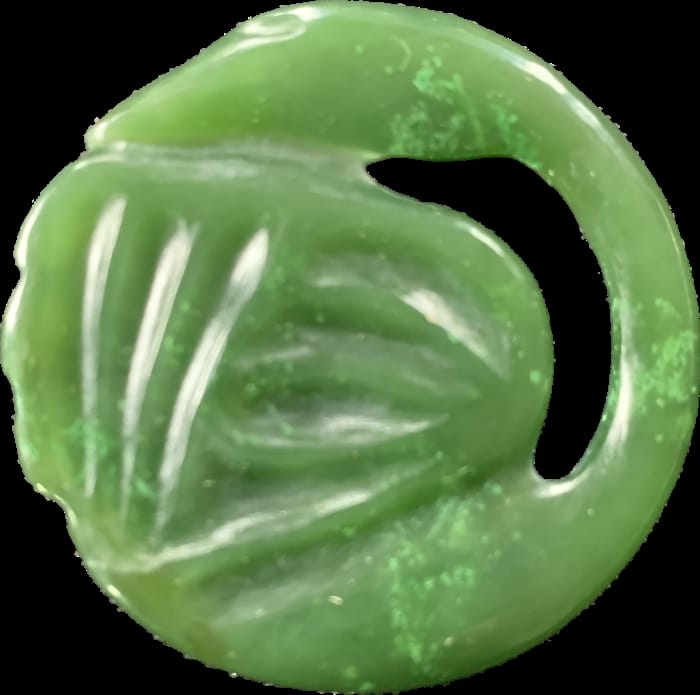Have I Discovered a New Ancient Civilization? MindBodyEvolution on video Episode 1
In the first video episode of MindBodyEvolution Dr. Josh Stout presents his possible discovery of a new culture, shows artifacts supporting his theories, and discusses what is fake, what is real, and the audacity to say you know the difference.

Below is lightly a edited AI generated transcript and there may be errors. Please scroll down for links below the transcript.
Eric:
Hi everybody, welcome to Mind Body Evolution on video. Can you believe it? This is Dr. Josh Stout.
Dr. Josh Stout:Hello.
Eric:We're going to talk about a possible new discovery that Josh has come up with. It's kind of a fascinating story. What do you got for us, Josh?
Dr. Josh Stout:All right. Well, it sounds really strange, but
Dr. Josh Stout:I think I might have discovered an unknown civilization or at least an unknown city with its own artistic tradition that probably lasted quite some time. And the whole thing is crazy. How would I be discovering new civilizations? I did it
online, buying things online. I love collecting and I like to buy marble statues because I think carving is beautiful and I enjoy it. And so I look for pretty little statues that I can find online. And I got one and suddenly I started to wonder, I'm not sure, but I started to wonder, is this something from a civilization that no one has ever talked about before?
Eric:But why? Why would that be even something that comes into your mind? I don't...
Dr. Josh Stout:Let me show you the piece. It's the only way I can describe it. Okay. It's going to take me moment. I put on my gloves. So these are...
Eric:Wait
Eric:, wait, why are you putting on gloves?
Dr. Josh Stout:So these are alabaster. Again, I say I look for marble. These were sold to me as marble, but it's really hard to tell online if you're looking at alabaster or marble. But when I got it, I realized that these were much more delicate. Alabaster is a softer stone than marble. It responds to moisture and you can get your...
Eric:So
Dr. Josh Stout:if your skin touches it over time, it can cause problems. It's fine if you touch it. You know, it's not a big deal, but I really don't want to cause a problem. These things, I think maybe have been around for, let's say maybe 4,000 years. And I don't want to be the one who really caused the problem.
Eric:Okay. Let's take a look. This is great. Very exciting.
Dr. Josh Stout:Okay.
Dr. Josh Stout:So this is an ibex, which is a kind of goat. It was sold to me as
a bull. It is clearly not a bull. You can see the spiraled horns, which bulls do not have. And I thought it was a nice enough carving to, you know, buy it. I could see that there was some details. I could see that there was some sort of crown up here that would have maybe had inserts or paint in it. I could see that there were inset eyes. And then I could even see that there was a socket for maybe an attached ear right here. And I thought, oh, those are some really interesting details. I want to buy this piece. It wasn't very expensive. It was being sold as sort of a knickknack, not really an artifact, not really something that was, you know, truly monumentally ancient, but just a thing you could buy online at an online auction. And it looked like it had been carved well, you know, so I was really interested in the way it had been carved. And so
Dr. Josh Stout:I bought it and it arrived. And then I tried to figure out where it was from. And that was when things got difficult. I started with figuring out what animal it was and where that animal could have lived. And so I got a line all the way from the Caucasus to the borders of Tibet. I thought it might be from somewhere that had a good carving tradition. So I was looking at places like India, Northern India, Pakistan, Afghanistan, I started to focus in on Afghanistan, because they really like that kind of goat there, the national goat of, of, of Afghanistan is a big furry mountain Ibex. And it's a large, impressive animal. And I thought that might be what I was looking at. You know, the, the, if you look at the artifact, again, you can see this is a, this is a large, muscular animal, with these with these spiral goat horns. And, uh, it didn't, it wasn't too far off of the kind of thing that, uh, an Afghani carver might make. I, I, I looked at pictures of them and I saw spiral goat horns on Afghani carvings. Uh, it was the only place I could find any,
Dr. Josh Stout:but the faces were wrong. The faces looked like goats. Whereas this one looks like a human.
Eric:Whoa.
Dr. Josh Stout:Let's take another look at it.
Eric:Face was wrong.
Dr. Josh Stout:Yeah.
Dr. Josh Stout:Let's take another look that. You see this face. It has these big, fat, happy cheeks. Um, and, and these inset eyes, the Afghani, uh, uh, people didn't seem to do that. Any, any of the various ethnic groups in Afghanistan didn't, didn't make a human like faces, uh, on their artifacts. And so I started to look at, um, I started to look online and I noticed there were more.
Eric:Hmm.
Dr. Josh Stout:And so I bought another one.
Eric:You were, you were specifically, you were specifically looking.
Dr. Josh Stout:I started realizing that this might be a thing. I didn't know quite what it was, but I saw there was another one from the same seller and they were selling a very similar piece. This one actually was a bull, but it has many of the same characteristics. So I could tell it was either from the same artist or it was from the same civilization.
Eric:Was it, was it labeled? I mean, how was it labeled?
Dr. Josh Stout:None
Dr. Josh Stout:of these things were labeled as, you know, possible Mesopotamian artifact or Sumerian artifact. These were, these were labeled as, um, uh,
ancient, uh, but from maybe the middle East, they, they might be labeled as a Roman thing. And I could tell they weren't that. And so I did, I didn't really believe the claims of their, of their ancient artifact. I thought that these were just handmade artifacts that had been, um, uh, you know, well-made at some point in time. And so when I looked at them, I was thinking, you know, maybe, maybe a 19th century piece, maybe a modern fake. I wasn't at all sure. But what was intriguing me was that I couldn't find any examples of modern fakes that looked like these things.
Eric:So, but what was it in that first one that made you, was it just a combination of features? What made you even look for another one?
Eric:What made you think there might be another one?
Dr. Josh Stout:Because I couldn't it down. I couldn't pin it down to any recognizable artistic style. It wasn't Indian. It wasn't Afghani. It wasn't Tibetan. It wasn't from Turkey. And it wasn't even from Mesopotamia, which is where I started to suspect, but it had some things in common with Mesopotamia. Mesopotamian artifacts. Again, they, they, they,
Dr. Josh Stout:they, they frequently have, uh, these, these inset eyes. They like adding things. So they, these, uh, these were insets for the horns, again, insets for the ears. Um, they liked putting human faces on their animals and it looked very similar with these, with these big fat, happy cheeks, but still not the same as, as a Mesopotamian artifact. I started to look at the pieces themselves and I would see, I would see, you know, significant aspects of age. And I started to wonder, are, are these older than I had imagined? These, these, these cracks here look like they were filled with mineral staining and that that wasn't added or wasn't part of the original stone. Now they could be. Sometimes you get a stone with veins in it and you carve it. Um, but these, these looked like maybe it had come in afterwards. Um, I could see signs of, um, of breakage and where, so looking at the bottom here, you can see the whole, the whole bottom has been broken off. And, uh, that, that started to make me think that I w I might be looking at something older. Uh, but
Dr. Josh Stout:the next thing I did was I started looking at old auctions and I found many, many more pieces. These were not ones I could buy.
Eric:You say old auctions, you mean, you mean
Dr. Josh Stout:auctions from previous
Eric:prior auctions that had already taken place, but there was a record.
Dr. Josh Stout:There was a record. And so I could look at the old auctions and find out what had been sold. And I was finding more fat, happy cheeks. I was finding, uh, uh, more of these sort of same expressions with the, with, with the inset eyes and the crowns. And I was finding a general, um, uh, sensibility.
Eric:So there was, there was a, there was actually a commonality between items that were listed as being from all over the,
Dr. Josh Stout:from all over the place and could be really anywhere in the world. There was, there was no way to know because nothing was labeled correctly at these auctions. And most of the things at these auctions were fake. So most all, almost all of the items at these auctions were fake.
Eric:What
Eric:is it that made you come to the, the feelings that this might be a whole civilization?
Dr. Josh Stout:Well, the more commonality I found, I got closer and closer to Sumerian things. But then as I studied Sumerian, Akkadian, Babylonian, Assyrian. Okay. So let, let me just state for, for, for the record, I am not a Mesopotamian expert. The bronze age is so huge. I was discovering new civilizations. Not that I was discovering. I was finding out about civilizations I had never heard about every day. I was doing research. There was some new thing I found out about that scholars had known about forever, but I didn't know about, you know,
Eric:so there's a bunch of civilizations out there that we just don't know but are known.
Dr. Josh Stout:There was 5,000 years of civilizations of which the Sumerians represented about 3,000 years, but they weren't the Sumerians. The Sumerians were actually just a previous earlier group. That's how we known them. They're mostly the Akkadians, um, following into the Babylonians and the Assyrians.
Eric:Which has, which has nothing to do with Akkadian driftwood. That's a completely different group.
Dr. Josh Stout:So anyway, I am, I am way out of my depth. I don't read the language. I don't read cuneiform, but I was starting to recognize, um, just as, as someone who loves art, who loves carving, uh, who loves understanding our history, that I was looking at something within this larger Mesopotamian tradition, but not any of the known examples. And, uh, let me show you… This
Eric:what is…because what does cuneiform have to do with…why do you say you didn't read cuneiform with…
Dr. Josh Stout:Okay, so…so we know about these civilizations because they left records that we can now read in cuneiform. And they left gigantic records, huge, huge entire libraries…
Eric:written records…
Dr. Josh Stout:And so we know a lot about them. We didn't know about them before the 19th century. We had biblical accounts of the Assyrians or people like that. But it was only in the 19th century we started reading the cuneiform and we were able to verify that this…all of this stuff actually happened. And so it…all of this started out as sort of Biblical exploration, trying to say, yeah, Nineveh actually existed. Ashurbanipal was a real king, you know, all of these things really, really happened.
Dr. Josh Stout:And so, by reading the cuneiform people started to figure that out. That's not me, okay? I…just looking at these things artistically started to think I might be looking at something
brand new…brand new in the sense…obviously old…but brand new in the sense of this has not been a civilization that we've been talking about.
Eric:All right, so you said you were going to show us another one.
Dr. Josh Stout:Yeah, so anyway, I want to show you this one again. Oh, okay. Looking at this
Dr. Josh Stout:bull…a bull could not physically lie down like this. This bull…
Eric:You mean…you mean there.
Dr. Josh Stout:…with these front legs pointing…a bull's legs would point backwards. This is the position of a sphinx. This is an Egyptian sphinx. Sumerian artifacts did not look like that. They…the bulls sat properly in Sumerian things.
Eric:It's
Eric:a bull in a sphinx pose.
Dr. Josh Stout:Exactly. And…and…and…and…the kind of things you might find in Iraq, you would not…would not look like that. That particular pose was another one of the commonalities. No faker would do that. I started to realize that…I was looking at things where either someone was a mad genius who had invented a civilization by putting together some things from Sumerian iconography with some pieces of Egyptian iconography. Or I was looking at a civilization that represented where these things had come together. They were all on the Silk Road. Anyone who was making bronze was digging it up in Afghanistan, digging up tin in Afghanistan and exporting it all the way to the Mediterranean, and the Mycenaean…the pre-Greek civilizations. All of that was coming all the way through these areas in Persia, in Iraq, in Syria. So these…these civilizations all had blending between them. And I think what this one is representing is a blend between the true Mesopotamian…literally between the river civilizations and some Egyptian civilization, possibly right on the border of…of…of…of… of…of…of the Mediterranean. I think there might even have been influences from this group of peoples…to…later… Greek civilizations.
Eric:Okay.
Dr. Josh Stout:I don't have any evidence for that right now. Okay,
Eric:but you have me excited now. I want to I want to see the next piece that…
Dr. Josh Stout:All right, so more pieces.
Eric:…that kind of drove you forward.
Dr. Josh Stout:Uh, all right.
Eric:Because I know that…I know that as you started…as you collected more of these pieces, you were getting even more excited about this…this idea.
Dr. Josh Stout:Okay, so this one is made of granite. And
Dr. Josh Stout:this is what is a really typical thing called a Lamassu. So Lamassu is this animal, human form. The…the typical ones would have been in Babylon or an Assyrian form. You can see them in the…in the…in the…in the Met. You'll see these…these…these…these…these large ones that were found in the…in the great palaces. And this looks very similar to them…except again, it's in this Sphinx form. All the Lamassu that I've seen pictures of were walking…and have this kind of beard. Very typical kind of Assyrian Babylonian type beard. Um, but combined with a Sphinx shape. And this one looks very much like a Sphinx.
Eric:Yeah.
Dr. Josh Stout:And you can see…I…uh…the…the feet are worn very, very badly worn which is amazing for…for granite to think about what it would take to wear it. Um…but…uh…I…I suspect that there were claws here on some of these other ones. You can see…you can see claws right at…right at the hip there. Um…but you combine that with these large…uh…Ibex horns. Um, and…uh…many…uh…many…uh…uh…lamassu…in Sumeria…uh…have these…uh…horn…uh…crowns…and they're formed of several bull horns all going back in rows. And they represent their…their…their gods, their forms of the gods. Lamassu means this protective deity. And they put them at the entrances to palaces, entrances to temples to protect the temple. Um…but these horned crowns…uh…are not what you're seeing on this one. So going back to it…it has a crown…and the crown is made of horns but they're not bull horns. And they're not in a row all on the same crown. They're two different kinds of…uh…horned animals. One a goat and one a sheep. So you've got the sheep horns right here at the top almost looking like a pair of goggles. And then you can see the rest of the crown here. So this
Eric:looks like a bowl.
Dr. Josh Stout:Then this…yes…and so these two horns are forming an offering bowl. Many of the artifacts…I only…I only…um…I was really looking at statues when I first started. But many of the artifacts in this larger collection, the ones I don't have, turn out to be offering bowls. Often with the face, with these puffy cheeks and the inside eyes, of a sort of semi-goat, semi-human face. And that's the other thing I want to talk about.
Eric:Um…so…so you think these were…you think these were used in…in ritualized… or ritual…
Dr. Josh Stout:These were…these were temple offerings. So these were…uh…and that's a…that's a common Sumerian cultural trait is to take…uh…small…uh…votive offerings and place them in a temple. So there are a lot of these offerings in Sumerian sites. Uh…this just doesn't match any of them. It doesn't match them in…in detail or the way they're done. So let me show you another thing. Alright. So on this one, you can see that the face is more or less flat. And that's…that's really typical of…uh…of most…you know…Babylonian, Sumerian. But it still has a little bit of this fat cheeks here. And if you compare it to…let's
say this first one again…this first
Dr. Josh Stout:one…you can see…really has the fat cheeks and a human-like face. But it's protruding forward. It…uh…it looks like a…an animal face. If you look directly at it, the nostrils are facing directly to you. That's not how human nostrils go. That's how animal nostrils look. And so this is…this is a half animal…uh…half…half
human face…uh…but…uh…one…done in the…in the…in the…in the…in the Sumerian style. But Sumerians didn't do it that way. When they did faces on their animals, they did a purely human face that was more or less flat. Not protruding like that. Um…I recognized it as Sumerian looking at pictures of…um…of Sumerian…uh…uh…uh…uh…uh…whorshippers. Uh…worshippers. So in addition to these animals, they would often have…um…uh…uh…uh…pictions of their kings…uh…uh…or of people worshipping in the temple. So you would put
Dr. Josh Stout:a…if you were a king, you would have a…a…uh…uh…uh…a statue made of yourself put in the temple looking at the…the…the god. And so you were constantly worshipping the god because you were there staring at the god. and…I
Eric:love it. I love it. Yeah. Love it. That…the outsourcing…the outsourcing the work of…of devotion. That's fantastic.
Dr. Josh Stout:And so here is one that really really represents that kind of tradition. And so this would have been a Sumerian king…uh…uh…sitting here on his throne. Uh…you can see these…uh…this pleated skirt coming down here. And again, I want to emphasize, these are not…the way they would appear if you you were looking at an actual Sumerian artifact in a museum, there would be several differences with this, which is why you could presume this is a fake, that an online site selling fakes, selling things that don't match known examples, almost certainly are fakes. And that's why I started to panic. I'm like, I don't know if these are real. I don't have the expertise.
Dr. Josh Stout:I've tried to contact a couple of museums like the British Museum or Columbia University.
Eric:How'd that go?
Dr. Josh Stout:They either ghosted me or they didn't want to talk to me. No one want to talk to me because these things either are fakes and no one wants to waste their time or they were looted. And then no one wants to get involved with something that was some sort of criminal.
Eric:They seem old. The museums don't want to look at them.
Dr. Josh Stout:Well, they don't want to look at them because that just encourages further looting. I'm not exactly sure how that all works, but you don't want to verify artifacts in a collector's collection if the collector is collecting recent stuff. Because if you verify that they're real, you have added to the value of that collection. You'v incentivized the collector to buy more looted artifacts.
Eric:This sounds like a self-defeating cycle in a number of different ways.
Dr. Josh Stout:For
Dr. Josh Stout:me, I started to really panic because, yeah, I couldn't get anyone to answer this stuff. I suspected they were fake because there was a lot of problems with them because they didn't match things. But I also suspected that they might be real. And at which point I was the only one who knew. And I was the only one who was able to put this stuff together.
Dr. Josh Stout:And that's where I wanted to bring up this idea of hubris of like, that's incredible hubris to think you're the only one who knows about this existing civilization. And started to have, you know, crisis of faith. Is this stuff true? And every time I would think these things, I would pick up an artifact again and realized, no, I have to do this. I really have an obligation to preserve as many of these records as I can. Why, why, why, why was the holding it? The thing that... Well, because I could, I could verify it. Something in your hand, you can, you can tell it's different from something you're looking at.
Eric:In your hand, you're really getting a feeling that this is possibly 4,000 years old. You're like,
Dr. Josh Stout:it's possible. But yeah, I, I really started to get that feeling. And, um,
Eric:but
Eric:these are also
verifiable fakes.
Dr. Josh Stout:Well, in the sense that they come from a place that only sells fakes. And when I finally got someone to look at them, he's like, yeah, these don't match real artifacts from Sumeria. These are fakes. And he, he flat out said them. And with, with, with a key point, let's take a look at this one.
Dr. Josh Stout:Again, the fakers, after they carved it, then shattered the stone, but whatever. Fine. If you look at the back here, you can see this cuneiform. So this is the, the Sumerian script, uh, with a line between that and cuneiform over here, except it's not. None of that is recognizable writing. Uh, this was a fake cuneiform. So the people who made it either
didn't know cuneiform and were writing in fake cuneiform, or it was a modern fake. And this whole piece is a modern fake.
Eric:When you say a modern fake, what is a modern?
Dr. Josh Stout:Yesterday through to the 19th century, it could have been a, you know, these could have been British grand tour going through, I don't know, Iraq, Syria, Egypt, even, uh, any of places
Eric:that would put it within, you know, a hundred to 200 years old.
Dr. Josh Stout:So, yeah. So I've got 100, 200
Eric:Made by a very skilled craftsman, artisan,
Dr. Josh Stout:who strangely knows some things again, back to this one. Um, this is all very, very, uh, classical, uh, Sumerian form in sort of its overall look, but
Dr. Josh Stout:there's several pieces that are just wrong. The pupils are much, much smaller. Uh, Sumerian, uh, pupils on the eyes would be most of that center inset, but someone went to the effort of making a, a chipped piece of stone and then a center, uh, and then drill the hole in it and put another, uh, piece of stone in there to have the black pupil and then glue that in using probably tar bitumen. Um, it seems like a lot of work. It seems like a lot of work. And then notice these hands, every single Sumerian votive statue would have the hands clasped at the chest and a faker would know that why put them down like this? Because that's how the Egyptians did it. The Egyptians had their hands when they would show a Pharaoh or a King, they'd have their hands resting on their knees like this. Um, so while it is possible that these were recent fakes, it would be someone who was purposely making something that didn't look like traditional fakes, right? That didn't look like what was actually out there. And so that was another question I asked, can I go out on the web and find fakes that look like mine? And the answer was no, I couldn't find all the fakes that are put out there. Yeah. Look like the real Sumerian artifacts because that's what they were copying. So then you're saying that all of your fakes came from one source, one source that doesn't match any known online sources that I've been finding. I've, I've, I've looked under carved marble. I've looked under antiquities. I've looked under artifacts. This would, this would lend the terms. This would lend itself to the, to the idea that like there's a cache of objects that were found, right? So I have pictures of all the ones that were sold at auction to record them. And yeah, I started, I started buying what I could, uh, you know, what I could afford, but they weren't that expensive because I think what might've been happening was that they were essentially laundering fake artifacts by using real artifacts. If you put things that are genuinely old next to something that is not old, it makes everything a little more uncertain. And it allows you to sell these things that are not old because someone might think they are old. They see something that they know is genuine and they say this thing next to it might be, might be good. It also allows you to sell things that if you're selling Iraqi artifacts online, uh, you're going to get caught. The police are going to come for you, especially if you're selling, let's say 40 of them. I think I found about 40 of these artifacts. So you're saying that they're using legitimate ancient artifacts purposely mislabeled to increase the value of actual fake artifacts. While being able to sell the real artifacts without getting in trouble for it. Yes. I think that's what's happening. But again, I don't know. I don't want to make any false accusations to anyone. Um, they might be legitimate businessmen.
Eric:Well, they, they are legitimate business. They also are legitimate businessmen. But what you purchased are verifiable fakes.
Dr. Josh Stout:Yes.
Eric:And have been verified as such.
Dr. Josh Stout:And they sell things on, on, uh, they sell things on commission. So they make, they make no claims about the, the, the truth of anything they're doing. Uh, they're selling it for someone else. So again, it's like eBay. You can't get eBay in trouble for the, if you look up, uh, Chinese antiquities on eBay, I guarantee you, every single one of them is fake. So, and, and eBay just said,
Eric:that's what they do. They just sell fake,
Dr. Josh Stout:they just sell fakes. And eBay is like, if you find a fake on eBay, report it and we'll, we'll get rid of that seller. That has never worked. So yeah. So the world is full of these fake artifacts and you can look for them. You can look for a fake Mesopotamian artifacts. So you get these very, very good, uh, carvings of granite Lamasu, just like I had, but costing twice as much. And they're from Thailand and they look better than mine. They look, they look more genuine because they're, they're, they're, they look, they were copied from Iraqi copies, uh, you know, from Iraqi originals. And so they look just like the Iraqi originals, but I can tell they're fakes cause they're coming from Thailand because that's not where the, you know, Iraqi artifacts were being, you wouldn't be finding those there. And, and they also look brand new. So, so they, you know, they, they don't have these signs, they're not broken.
Eric:I know you have other objects
Dr. Josh Stout:and we don't need to show them all today.
Eric:We will show them what do you, what, uh, what, what, what are the next steps here?
Dr. Josh Stout:What are the next steps for me?
Eric:Yeah,
Eric:for you. Yeah.
Dr. Josh Stout:Yeah. So I, I, I want to, I want to, I want to show a few more of these artifacts at a couple, a couple more of these to talk about aspects of the culture. I want to talk about what a Lamasu is. I want to talk about Sumerian culture in general. I have some things, uh, the, the, the, they did weighting, uh, using ducks. They would carve a duck and that was their weight. I have one of those. I want to talk about that and how, how they came up with their number systems. You know, we get, we have, uh, a second, 60 seconds to a minute and 60 minutes to an hour and 365 days in a year. That's all, that's all Babylonian Sumerian stuff. We have 360 degrees in a circle because of them. And so, uh, we have these things in our culture and I get to talk about that because of the artifacts
Eric:excellent.
Dr. Josh Stout:So anyway, that that's where I want to go in the future.
Eric:Excellent. All right. And there will be more artifacts to come
Dr. Josh Stout:and there are more artifacts to come. This is a crazy, crazy situation. One, one last thing I want to say
Eric:please, please, please.
Dr. Josh Stout:Reason. Okay. I love things.
Dr. Josh Stout:I'm not now buying these because I just want to have a collection. I think I'm protecting them and I want to, I want to point out that it is terrible to loot. A city somewhere in the middle east to sell these things. But now that I've found them, the only, the only value they have really to the archaeological record is their context. And I have their context that they're related to each other. I see, I have the pictures of the ones that were sold and I have the ones in my possession. And so I have a cohesive collection from a particular site. And so they do still have a context to themselves. We don't know where they were found. We don't know what country they're from, but I think they do have a context. And I just wanted to point that, point that out.
Eric:Excellent. Excellent. Well, thank you, Josh, as always. Fascinating.
Dr. Josh Stout:Thank you.
Eric:Let's say goodbye to everyone.
Dr. Josh Stout:Goodbye.
Eric:Thanks y'all. Keep, keep watching Mind Body Evolution on video. Take care, everyone. Until next time.

Theme Music
Theme music by
sirobosi frawstakwa







